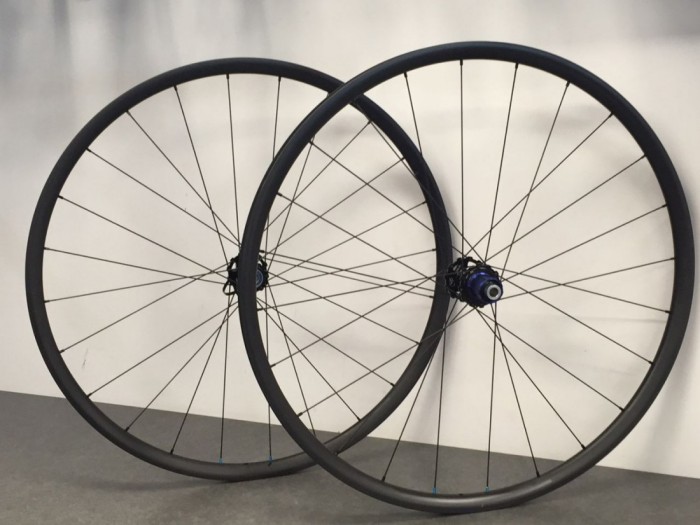Carbon wheels are slowly becoming de rigeur for elite endurance mountain biking. The internet, trails and cafes are awash with carbon bike parts. And for good reason – carbon fibre can be used to make stiffer, lighter, stronger and even more comfortable frames, forks, handlebars, stems, seat posts and rims. The returns aren’t as noticeable for some parts. But if you rode an alloy framed hardtail with alloy seatpost, and then a carbon frame with carbon seatpost – chances are you would notice the difference.
The argument for carbon fibre rims is pretty strong. We all wanted lighter rims for 29ers especially, but then who hasn’t lamented a dented sidewall once they have a 1300-1500g 29er race wheel, or lack of stiffness under hard riding? The right carbon-rimmed wheel set might be about the same weight, but stiffer, and with a stronger rim.
While it’s justifiable to be concerned about the fragility of a carbon fibre rim, the right rim will be very strong. Personally, having owned about 6 carbon wheel sets, I’ve never dented or cracked one. But I’ve written off a few light alloy ones.
Chances are you’re reading this as you’re sold on the idea of a light, strong rim – just maybe not at over $2000 for the wheels.
We have had two sets of carbon fibre rimmed wheels built up. Both sets of rims came from the one manufacturer. We used Sapim Laser spokes with alloy nipples, and had Joe Dodd from Summit Cycles build both sets.
The Super Light Set
Ok so this could have been lighter, but this set also used a set of hubs sourced online as well. These were the Circus Monkey M5 24 hole hubs, set for a QR15 front hub and 142×12 rear hub. The rims were 27mm Nextie Bike Hookless Clincher rims, code NXT29H04.
Build Report
While we didn’t use a super light aero spoke (figuring that might be over investment) these wheels built up smoothly, and very light at exactly 1300g without tape and valves. Joe said they were easy to build, and thought the finish on the rim was great.
But there were still concerns though. The hubs have flanges that are highly relieved, and not that high. So there’s actually less support for the spoke than usual, which might add extra stress at the bend – one of the key places for a spoke to break.
One of the perils of buying online is not getting to touch and feel the product. In this case, the front hub has end caps that don’t stay in place. Unless the wheel is in the bike. This is a major hassle if you need to take your wheels off to transport your bike, or get a flat. It even means it’s a bit of a hassle if you swap wheels much.
Setup and Riding
With 23mm Stan’s yellow tape and some nifty Mt Zoom alloy valves, the Maxxis Ikone EXO 2.0″ tyres inflated with a track pump. The rims are said to be tubeless compatible, but sometimes that’s not as easy as is claimed. In this case, it was.
With rotors mounted, very minimal adjustment of the callipers was required. No more than when swapping wheels with other hubs.
The freehub has pretty good pick up, but the rear hub is certainly 142×12 specific. No changing the axle to run 135 QR it seems. The bearings feel great in the hand, but with the wheel in the bike there’s enough lateral play that you can feel the wheel move. Not when riding, but it’s there. There’s no option to take it up. Higher quality bearings may help.
Riding has been fine so far. They’re not that stiff, and the front is noticeably less stiff than a Stan’s ZTR Valor front wheel, which is also 24 hole. This is more likely to be from the hub than the rim, due to the low flange height.
Even with pressures of 22psi (in 2.0″ tyres) I haven’t managed to burp the tyres. The wheels have held pressure really well so far. The rim sidewalls aren’t that thick. I’m not about to go hucking off anything on this set of wheels, but the hookless design does pull some material out from this area. It’s a concern.
Costs
The rims cost $160USDea, the spokes were $1.45ea and labour from Summit Cycles was $199 for the set. So, with shipping and the exchange rate, tape and valves, the wheels cost about $750.
If you used lighter spokes, it would change the price dramatically, but would drop the wheel weight a little – an investment into better hubs with greater flange height and better axle compatability (or just secure end caps) would also be wise. But so far, the rims seem great. Time will tell on that thought.
Concerns
Beyond the rim side walls, it’s just the hubs really. With higher priced hubs and spokes used, you start to get closer to a ‘known’ carbon wheel. And what cost do you put on having a company to fall back on for warranty and repair? That’s a question only you as a buyer, rider, and owner can answer.
We’ll go over the build of our second set in a further post.

